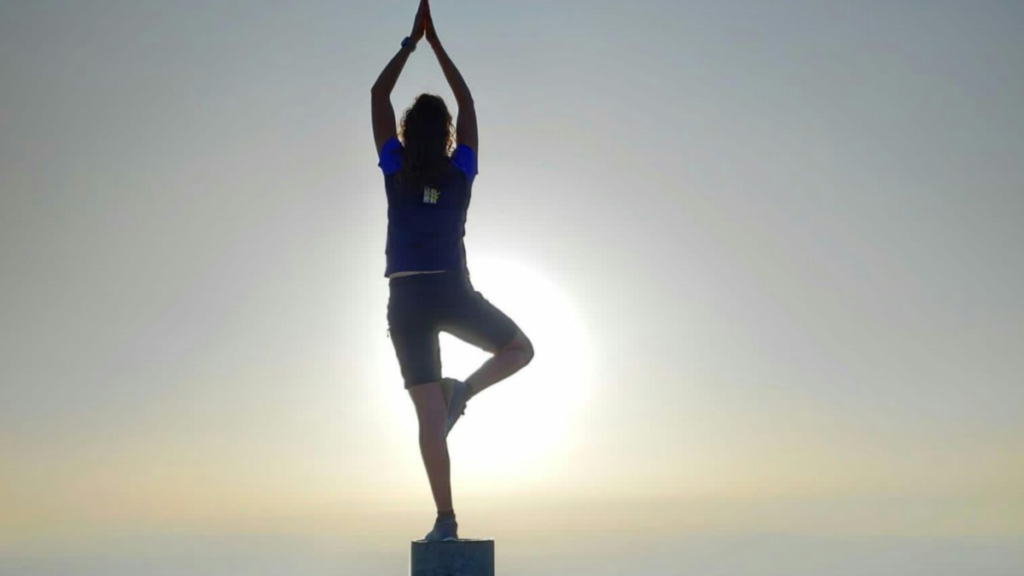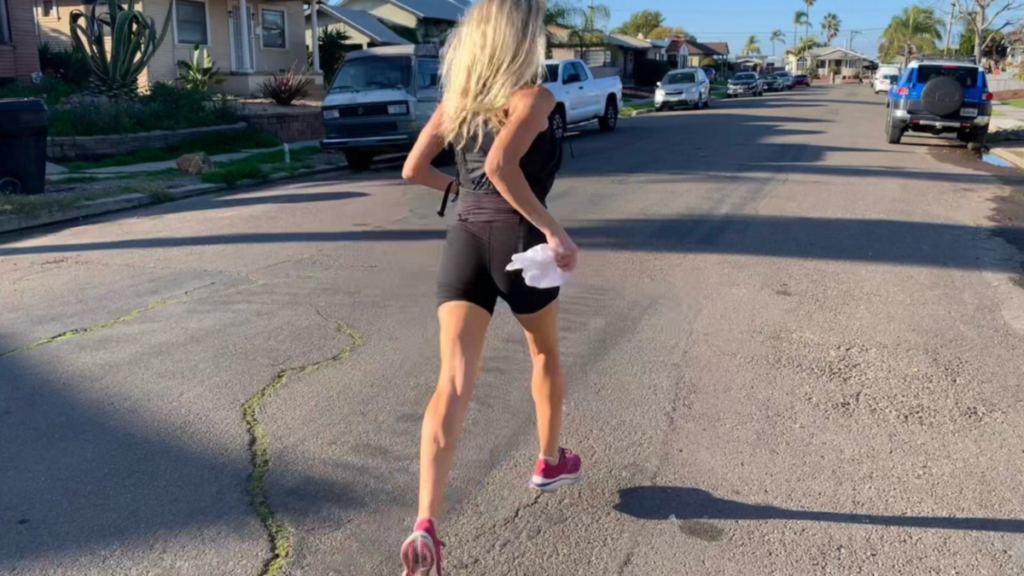
Once again I’m at a stage of my life where I want to slim down my legs. It’s called springtime… At the end of winter each year, my summer clothes never seem to fit the way I want them to. Hopefully my early spring running program will help me fit into my trousers better than I’m able to at the moment.
Running engages multiple muscle groups in the legs, promoting muscle toning and fat burning simultaneously. This helps achieve leaner legs, as it reduces overall fat mass while sculpting the muscles underneath. However, we all vary based on genetics, diet, and overall physical activity levels.
Let’s take a closer look at the ways that we can use running to slim down our legs.
Can Running Slim Legs
Running is often touted as an effective way to slim down legs, supported by scientific evidence. The act of running engages multiple muscle groups in the legs, promoting muscle toning and fat burning simultaneously. This dual effect is crucial for achieving leaner legs, as it helps to reduce overall fat mass while sculpting the muscles underneath. Additionally, running is a cardiovascular exercise that elevates heart rate and boosts metabolism, further aiding in fat loss throughout the body, including the legs.
Physiologically, running triggers the body to tap into its fat stores for energy, making it an efficient way to burn excess fat, especially in the lower body region. However, it’s important to note that individual results may vary based on factors such as genetics, diet, and overall physical activity levels. Some individuals may experience more significant slimming effects in their legs from running compared to others.
While running can be a powerful tool for slimming legs, it’s essential to complement it with a balanced diet and strength training to achieve optimal results. By incorporating running into a holistic fitness routine, individuals can work towards achieving leaner and more toned legs effectively.
The Role of Cardiovascular Exercise
Cardiovascular exercise, such as running, plays a crucial role in transforming body composition by targeting fat stores, including those in the legs. When engaging in cardio activities, the body’s energy demands increase, leading to the utilization of stored fat for fuel. Running, in particular, is known for its ability to elevate heart rate and boost metabolism, creating a favorable environment for fat loss.
By consistently incorporating cardiovascular exercises like running into your fitness routine, you can effectively reduce overall body fat, including in the legs. Running not only burns calories during the activity but also continues to do so post-workout due to the elevated metabolic rate. This extended calorie burn contributes to a gradual reduction in fat mass, helping to reveal leaner and more toned leg muscles.
Understanding the relationship between running and fat loss is essential for individuals looking to slim down their legs. By making cardiovascular exercise a regular part of your fitness regimen, you can work towards achieving a healthier body composition and promoting fat loss, ultimately leading to leaner legs.
Muscle vs. Fat: Understanding the Difference
Muscle tissue and fat tissue are two distinct components of the body with different functions and appearances. Muscle is dense and metabolically active, contributing to strength, endurance, and overall body shape. In contrast, fat is less dense and serves as an energy store. Running, as a cardiovascular exercise, targets fat stores for energy, aiding in fat reduction throughout the body, including the legs. By engaging in regular running sessions, individuals can promote fat loss while potentially toning leg muscles.

It’s crucial to understand the importance of a balanced approach to exercise. While running can be effective for fat loss, incorporating strength training exercises can help build and maintain muscle mass. This balanced approach not only supports overall fitness but also contributes to a toned and sculpted appearance. By combining cardiovascular activities like running with strength training, individuals can achieve a harmonious blend of fat reduction and muscle development, leading to leaner and more defined legs.
Incorporating Interval Training for Leaner Legs
By incorporating interval training into your running routine, you can maximize the benefits of your workout for achieving leaner legs. Interval training involves alternating between high-intensity bursts of activity and periods of rest or lower intensity. This approach not only boosts calorie burn during the workout but also increases your metabolism post-exercise, leading to greater fat loss, including in the legs.
One effective interval training workout for slimmer legs is sprint intervals. Start with a warm-up jog, then sprint at maximum effort for 30 seconds followed by a 1-minute recovery jog. Repeat this cycle for 15-20 minutes. Another option is hill intervals, where you sprint up a hill for 20-30 seconds and then walk or jog back down for recovery.
These high-intensity intervals challenge your muscles and cardiovascular system, promoting fat burning and muscle-toning in the legs. By incorporating interval training into your running routine a few times a week, you can accelerate your progress towards leaner and more defined legs.
Nutrition Tips to Support Your Running Goals
Nutrition plays a crucial role in supporting your running goals for achieving slimmer legs. By fueling your body with the right nutrients, you can optimize your performance, aid in muscle recovery, and promote fat loss. To complement your running regimen, focus on a balanced diet rich in lean proteins, complex carbohydrates, healthy fats, and plenty of fruits and vegetables.
Incorporating foods like lean meats, fish, whole grains, nuts, seeds, and leafy greens can provide the necessary nutrients for energy and muscle repair. Hydration is also key for optimal performance, so make sure to drink an adequate amount of water throughout the day and especially before and after your runs.
Consider structuring your meals around your running schedule to ensure you have the energy needed for your workouts. Pre-run snacks could include a banana with almond butter or Greek yogurt with berries, while post-run meals might consist of grilled chicken with quinoa and roasted vegetables or a smoothie with protein powder and spinach.
By paying attention to your nutrition and making smart dietary choices, you can enhance your running performance, support muscle growth, and work towards achieving those leaner legs you desire.
Strengthening Leg Muscles: Beyond Running
To enhance overall leg definition and strengthen leg muscles beyond running, incorporating a variety of exercises and activities is essential. Cross-training plays a crucial role in targeting different muscle groups and preventing overuse injuries. Activities such as cycling, swimming, and strength training can complement running by engaging muscles in different ways.

Cycling, for example, is a low-impact exercise that targets the quadriceps, hamstrings, and calves while providing a cardiovascular workout. Swimming engages the entire lower body, including the glutes, quads, and calves, while also improving flexibility. Strength training exercises like squats, lunges, deadlifts, and calf raises help build muscle strength and endurance, contributing to better overall leg definition.
Incorporating these diverse activities not only helps prevent muscle imbalances but also enhances overall athletic performance. By engaging in cross-training, you can improve your running efficiency, reduce the risk of injuries, and achieve a more balanced and sculpted lower body. Remember, variety is key to challenging your muscles in different ways and achieving optimal results in your quest for slimmer and stronger legs.
Avoiding Common Mistakes in Running Technique
Common Mistakes in Running Technique can significantly impact your progress in slimming down your legs. One common mistake is overstriding, where your foot lands too far in front of your body, leading to inefficient movement and increased risk of injury. To avoid this, focus on maintaining a shorter stride length and landing your foot directly underneath your body.
Another mistake is improper posture, such as hunching over or leaning too far back. This can strain your muscles and affect your breathing. Ensure you maintain a tall posture with your head up, shoulders relaxed, and core engaged to optimize your running form.
Additionally, neglecting warm-up and cool-down routines can hinder your performance and recovery. Always start with a dynamic warm-up to prepare your muscles and joints for the run, and finish with a proper cool-down to aid in muscle recovery and prevent stiffness.
By addressing these common mistakes and implementing proper running techniques, you can enhance your running efficiency, reduce the risk of injuries, and maximize the benefits of your workouts. Remember, focusing on form and technique is key to achieving your goals of slimmer and stronger legs.
Overcoming Plateaus and Challenges
When striving to slim down legs through running, individuals may encounter common plateaus and challenges that can hinder progress. One common plateau is reaching a point where weight loss or muscle toning seems to stall despite consistent effort. This can be frustrating and demotivating for many runners. Another challenge is dealing with muscle soreness and fatigue, especially when increasing running intensity or duration.
To overcome these obstacles, it’s essential to incorporate variety into your running routine. Mixing up your running routes, speeds, and inclines can help prevent plateaus and keep your body challenged. Additionally, focusing on strength training exercises for the legs can complement your running routine and break through stagnant progress.
Addressing muscle soreness and fatigue requires proper recovery techniques, such as foam rolling, stretching, and adequate rest days. Listening to your body and giving it the rest it needs is crucial for long-term success in slimming down your legs through running.
By recognizing and proactively addressing these plateaus and challenges, you can stay motivated, break through barriers, and continue progressing towards your goal of leaner and stronger legs.
The Importance of Rest and Recovery
Rest and recovery play a crucial role in any running routine focused on slimming legs. Adequate rest allows your muscles to repair and grow stronger, which is essential for progress and preventing injuries. Similarly, proper recovery techniques, such as foam rolling and stretching, help alleviate muscle soreness and improve flexibility, enhancing your overall performance.
In addition to physical rest, the importance of sleep cannot be overstated. Quality sleep is when your body undergoes repair and regeneration processes, crucial for muscle recovery and overall well-being. Hydration is another key aspect of rest and recovery, as staying hydrated supports muscle function and aids in the removal of toxins from the body.
By prioritizing rest, quality sleep, and hydration in your running routine, you not only optimize your leg-slimming efforts but also promote better overall health and performance. Incorporating these elements into your routine will help you recover faster, reduce the risk of injury, and ensure that you can continue making progress towards your fitness goals.
Setting Realistic Goals and Tracking Progress
Setting realistic goals is crucial when aiming to slim legs through running. Start by defining clear and achievable objectives that align with your fitness level and lifestyle. Whether it’s increasing your running distance, improving your pace, or targeting specific areas for muscle toning, setting realistic goals will keep you motivated and focused on your leg-slimming journey.
To track your progress effectively, consider using a running journal or fitness app to log your workouts, distances, times, and any other relevant data. This not only helps you monitor your improvements but also allows you to identify patterns, adjust your training as needed, and stay accountable to your goals.
Consistency is key when it comes to achieving results. Stay committed to your running routine, even on days when motivation is low. Remember that progress takes time, and patience is essential. Celebrate small victories along the way, whether it’s completing a challenging run or noticing improvements in your strength and endurance.
By setting realistic goals, tracking your progress, and maintaining consistency, you’ll be on the right path to slimming your legs through running while building a strong foundation for long-term success.
Mind-Body Connection: Mental Strategies for Success
The mental aspect plays a significant role in slimming legs through running. Motivational techniques can help you stay committed to your fitness journey, especially on challenging days. Positive self-talk is crucial in boosting confidence and overcoming self-doubt during runs. By replacing negative thoughts with affirmations, you can enhance your performance and mindset.

Visualization exercises are powerful tools to mentally prepare for runs and envision success. By picturing yourself achieving your running goals, you can increase motivation and focus. Visualizing crossing the finish line or conquering a tough hill can help you push through physical barriers and stay determined.
Additionally, setting intentions before each run can help align your mind and body towards a common goal. Whether it’s focusing on improving your form, increasing your speed, or simply enjoying the run, setting intentions can enhance your overall running experience and mindset.
By incorporating motivational techniques, positive self-talk, visualization exercises, and setting intentions, you can strengthen the mind-body connection and optimize your mental strategies for success in slimming your legs through running.
Celebrating Non-Scale Victories
It’s essential to shift the focus from solely relying on the number on the scale to celebrating a broader spectrum of achievements. Recognizing improvements in strength, endurance, and overall well-being is equally, if not more, important in your fitness journey.
When you acknowledge non-scale victories, such as being able to run longer distances without feeling fatigued, completing a challenging workout, or feeling more energized throughout the day, you are celebrating tangible progress that goes beyond mere numbers. These victories reflect your dedication, hard work, and commitment to your health and fitness goals.
By celebrating non-scale victories, you cultivate a positive mindset and reinforce the idea that success is not solely defined by a specific weight or size. Embracing these achievements boosts your confidence, motivation, and overall well-being, creating a more sustainable and fulfilling fitness journey.
Remember, progress comes in various forms, and each milestone, no matter how small, deserves recognition and celebration. So, take pride in your non-scale victories and let them fuel your continued success on your running and fitness endeavors.
